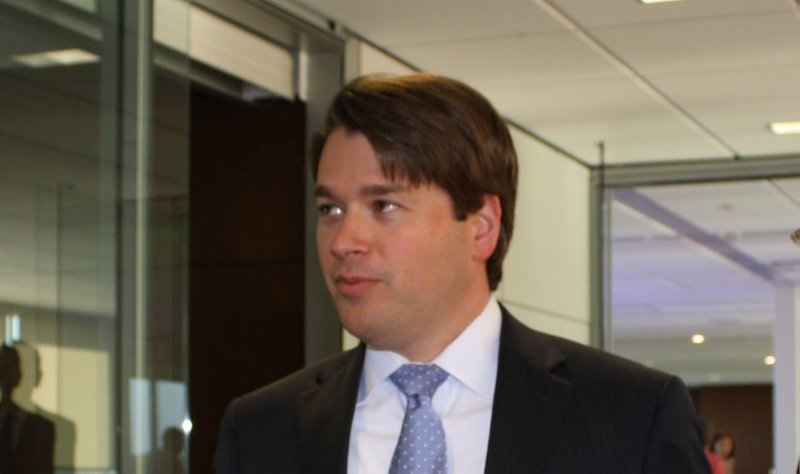HOT SPRINGS -- The Arkansas Public Employees Retirement System wants to minimize the impact on its members if any action is taken to change their benefits, the system's executive director told lawmakers and county officials on Thursday.
"You would want to make sure there is no reduction in previously earned service," system Executive Director Duncan Baird said. "In fact, legally you probably couldn't do that anyway. But I just wanted to note that ... that would be obviously a factor and a consideration.
"The other one would be ... to ensure that there is no reduction in the amount of any benefit currently being received, so retirees receiving a benefit this year ... wouldn't expect to see that benefit go down," he told the Legislature's Joint Committee on Public Retirement and Social Security Programs. The meeting took place with about 200 people there for an Association of Arkansas Counties conference.
"I think those are important considerations for any legislative discussion," said Baird, who is a former Republican state representative from Lowell and state budget administrator. He started work at the system in April.
Three officials representing the system's working and retired members then stressed to lawmakers the importance of retirement benefits in recruiting and retaining county employees.
One retired member urged lawmakers not to tinker with the 3% compound cost-of-living adjustment paid to retirees each year under state law. The retiree also urged lawmakers not to shift to trustees the authority for setting the cost-of-living adjustment.
Another county official suggested an option to help counties afford a potential increase in the rate charged to state and local governments.
The system's liabilities were 79% funded, with $8.4 billion in assets and $10.6 billion in liabilities at the end of fiscal 2018 on June 30, 2018.
The system collected $341 million in contributions from both employers and employees in fiscal 2018, while paying $530 million in benefits, Baird noted.
If the system earns an investment return of 4% in fiscal 2020, which started July 1, and then hit the target return of 7.15% in each of the following three fiscal years, the rate charged to state and local governments could gradually increase from 15.32% of payroll to 18.7% over a five-year period and the funding percentage rate drop into the low 70s under one scenario put together by the system's actuary, he said.
The system's liabilities are increasing at a steady pace, while the value of investments is volatile, Baird said.
"If our assumptions are not met, then the cost of the plan could increase significantly. That's the risk that we face as we look forward into the future," he said.
More than 40 states have adjusted retirement benefits lower for public pension systems since 2009 based on information from the National Association of State Retirement Administrators, Baird said.
"At least for me, smaller adjustments sooner, it seemed like, would help avoid larger adjustments in the future," he said.
It's important for the retirement system to learn from and adopt changes enacted for other retirement agencies such as the Arkansas Teacher Retirement System, Arkansas State Highway Employees Retirement System or the Arkansas Local Police and Fire Retirement System, Baird said.
Bills were introduced in this year's regular legislative session to change the Public Employees Retirement System's 3% compound cost-of-living adjustment; gradually increase the rate charged to working members from 5% of their pay to 6%; and change the calculation of benefits for new members, he noted. None of these bills cleared the retirement committee.
But the nation is about 10 years into this economic recovery and unemployment is low, Baird said.
"In the back of everybody's mind is just this idea that these are really good times, so when you look forward, you can't assume that times will necessarily be as good," he said. "Maybe there is a recession at some point. We know it will happen at some point, but there is no predicting that."
Sen. Kim Hammer, R-Benton, said, "The messaging that we were getting during the session was that everything was fine" with the system. He also said Rep. Doug House, R-North Little Rock, was "crucified" over his bill to grant the system's trustees the authority to determine the cost-of-living adjustment for retired members with a maximum of a "simple" 3% cost-of-living adjustment.
Pulaski County Treasurer Debra Buckner told lawmakers that the bills filed this year to change the system "were a big surprise to most of us in this room."
The rate charged to state and local governments -- 15.32% of payroll -- could more than likely be increased and counties might be able to afford the increase if the state raised the $30 per day it pays counties to hold each state inmate, she said. Each inmate costs a county about $60 per day, she said.
Former Pope County Collector Rita Chandler told lawmakers, "Please do not reduce the [cost-of-living adjustment] for the compound of our retirement benefits. ... We considered that COLA a promise. It is our hope that we would at least be grandfathered in," she said.
Chandler said retirees oppose legislation that would allow the trustees to determine the cost-of-living adjustment for benefits each year.
"We request that that power remain with our legislators. We are more connected to you than we would a nine-member board, and we hope you would see that also and keep that power," she said.
Chandler also suggested adding a retired member to the nine-member board of trustees.
The public employees system included 45,965 working members with an average annual salary of $39,213 as of June 30 this year, according to a preliminary report from the system actuary, Gabriel Roeder, Smith & Co. The report showed that the average age of these working members is 44.7 and their average length of service is 9.4 years.
The system's 36,914 retirees were paid $554.8 million (or an average of $14,758 a year) as of June 30, according to the actuary's report.
Metro on 08/23/2019
